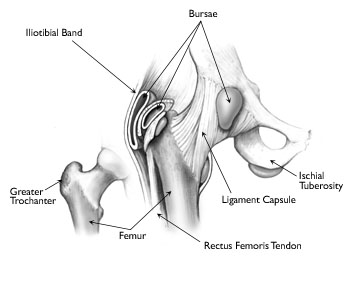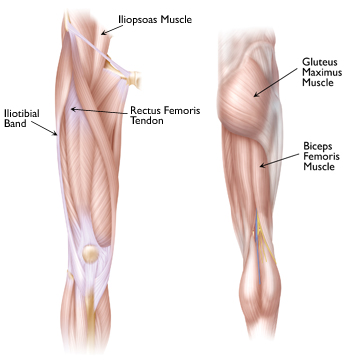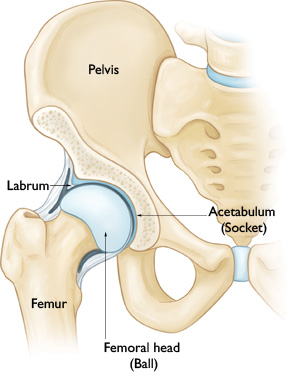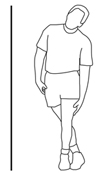
Snapping Hip
Snapping hip is a condition in which you feel a snapping sensation or hear a popping sound in your hip when you walk, get up from a chair, or swing your leg around.
The snapping sensation occurs when a muscle or tendon (the strong tissue that connects muscle to bone) moves over a bony protrusion in your hip.
Although snapping hip is usually painless and harmless, the sensation can be annoying. In some cases, snapping hip leads to bursitis, a painful swelling of the fluid-filled sacs that cushion the hip joint.
AnatomyThe hip is a ball-and-socket joint formed where the rounded end of the thighbone (femur) fits into a cup-shaped socket (acetabulum) in the pelvis. The acetabulum is ringed by strong fibrocartilage called the labrum that creates a tight seal and helps to provide stability to the joint.
Encasing the hip are ligaments that surround the joint and hold it together. Over the ligaments are tendons that attach muscles in the buttocks, thighs, and pelvis to the bones. These muscles control hip movement.
Fluid-filled sacs called bursae are located in strategic spots around the hip to provide cushioning and help the muscles move smoothly over the bone.
 (Left) The bones of the hip. (Right) Ligaments, tendons, and bursae surround and protect the hip joint.
Reproduced with permission from The Body Almanac. © American Academy of Orthopaedic Surgeons, 2003.
Description
(Left) The bones of the hip. (Right) Ligaments, tendons, and bursae surround and protect the hip joint.
Reproduced with permission from The Body Almanac. © American Academy of Orthopaedic Surgeons, 2003.
Description
Snapping hip can occur in different areas of the hip where tendons and muscles slide over knobs in the hip bones.
- Outside of the hip. The most common site of snapping hip is at the outer side where the iliotibial band passes over the portion of the thighbone known as the greater trochanter.
When the hip is straight, the iliotibial band is behind the trochanter. When the hip bends, the band moves over the trochanter so that it is in front of it. The iliotibial band is always tight, like a stretched rubber band. Because the trochanter juts out slightly, the movement of the band across it creates the snap you hear.
Eventually, snapping hip may lead to hip bursitis. Bursitis is thickening and inflammation of the bursa, a fluid-filled sac that allows the muscle to move smoothly over bone.
 (Left) This front-view of the hip and thigh shows musculature most often associated with snapping hip: the iliotibial band, rectus femoris tendon, and iliopsoas muscle. (Right) The biceps femoris hamstring muscle travels under the gluteus maximus and can snap as it moves over the ischial tuberosity.
Reproduced with permission from JF Sarwark, ed: Essentials of Musculoskeletal Care, ed 4. Rosemont, IL, American Academy of Orthopaedic Surgeons, 2010.
(Left) This front-view of the hip and thigh shows musculature most often associated with snapping hip: the iliotibial band, rectus femoris tendon, and iliopsoas muscle. (Right) The biceps femoris hamstring muscle travels under the gluteus maximus and can snap as it moves over the ischial tuberosity.
Reproduced with permission from JF Sarwark, ed: Essentials of Musculoskeletal Care, ed 4. Rosemont, IL, American Academy of Orthopaedic Surgeons, 2010.
- Front of the hip. Another tendon that could cause a snapping hip runs from the front of the thigh up to the pelvis (rectus femoris tendon). Snapping of the rectus femoris tendon is felt in the front of the hip. As you bend the hip, the tendon shifts across the head of the thighbone, and when you straighten the hip, the tendon moves back to the side of the thighbone. This back-and-forth motion across the head of the thighbone causes the snapping.
- Back of the hip. Snapping in the back of the hip can involve the hamstring tendon. This tendon attaches to the sitting bone, called the ischial tuberosity. When it moves across the ischial tuberosity, the tendon may catch, causing a snapping sensation in the buttock region.
- Cartilage problems. The labrum that lines the socket of the hip can tear and cause a snapping sensation. Damaged cartilage can loosen and float in the joint causing the hip to catch or "lock up." This type of snapping hip usually causes pain and may be disabling.
In addition to the rectus femoris tendon at the front of the hip, the iliopsoas tendon can catch on bony prominences at the front of the pelvis bone.
 Snapping or catching in the hip can also be caused by tears in the labrum or damage to the cartilage that covers the bones of the joint.
Cause
Snapping or catching in the hip can also be caused by tears in the labrum or damage to the cartilage that covers the bones of the joint.
Cause
Snapping hip is most often the result of tightness in the muscles and tendons surrounding the hip. People who are involved in sports and activities that require repeated bending at the hip are more likely to experience snapping hip. Dancers are especially vulnerable.
Young athletes are also more likely to have snapping hip. This is because tightness in the muscle structures of the hip is common during adolescent growth spurts.
Home RemediesMost people do not see a doctor for snapping hip unless they experience some pain. If the snapping hip bothers you — but not to the point of seeing a doctor — try the following conservative home treatment options:
- Reduce your activity levels and apply ice to the affected area.
- Use nonsteroidal anti-inflammatory drugs, such as aspirin or ibuprofen, to reduce discomfort.
- Modify your sport or exercise activities to avoid repetitive movement of the hip. For example, reduce time spent on a bicycle, and swim using your arms only.
If you are still experiencing discomfort after trying these conservative methods, consult your doctor for professional treatment.
Doctor ExaminationMedical History and Physical Examination
Your doctor will first determine the exact cause of the snapping by discussing you medical history and symptoms, and conducting a physical examination. He or she may ask you where it hurts, what kinds of activities bring on the snapping, whether you can demonstrate the snapping, or whether you have experienced any injury to the hip area.
You may also be asked to stand and move your hip in various directions to reproduce the snapping. Your doctor may even be able to feel the tendon moving as you bend or extend your hip.
Imaging Tests
X-rays create clear pictures of dense structures, like bone. Although x-rays of people with snapping hip do not typically show anything abnormal, your doctor may order x-rays along with other tests to rule out any problems with the bones or joint.
TreatmentInitial treatment typically involves a period of rest and modification of activities. Depending upon the cause of your snapping hip, your doctor may also recommend other conservative treatment options.
Physical Therapy
Your doctor may prescribe exercises to stretch and strengthen the musculature surrounding the hip. Guidance from a physical therapist may also be recommended.
 Iliotibial band stretch
Iliotibial band stretch
- Iliotibial band stretch
- Stand next to a wall for support
- Cross the leg that is closest to the wall behind your other leg.
- Lean your hip toward the wall until you feel a stretch at the outside of your hip. Hold the stretch for 30 seconds.
- Repeat on the opposite side.
- Perform 2 to 3 sets of 4 repetitions each side.
- Piriformis stretch
- Lie on your back with bent knees and feet flat on the floor.
- Cross the foot of the affected hip over the opposite knee and clasp your hands behind your thigh.
- Pull your thigh toward you until you feel the stretch in your hip and buttocks. Hold the stretch for 30 seconds.
- Repeat on the opposite side.
- Perform 2 to 3 sets of 4 repetitions each side.
 Piriformis stretch
Exercise illustrations reproduced with permission from JF Sarwark, ed: Essentials of Musculoskeletal Care, ed 4. Rosemont, IL, American Academy of Orthopaedic Surgeons, 2010.
Piriformis stretch
Exercise illustrations reproduced with permission from JF Sarwark, ed: Essentials of Musculoskeletal Care, ed 4. Rosemont, IL, American Academy of Orthopaedic Surgeons, 2010.
Corticosteroid Injection
If you have hip bursitis, your doctor may recommend an injection of a corticosteroid into the bursa to reduce painful inflammation.
Surgical Treatment
In the rare instances that snapping hip does not respond to conservative treatment, your doctor may recommend surgery. The type of surgery will depend on the cause of the snapping hip.
- Hip arthroscopy. During hip arthroscopy, your surgeon inserts a small camera, called an arthroscope, into your hip joint. The camera displays pictures on a television screen, and your surgeon uses these images to guide miniature surgical instruments.
- Open procedure. A traditional open surgical incision (several centimeters long) may be required to address the cause of the snapping hip. An open incision can help your surgeon to better see and gain access to the problem in the hip.
Because the arthroscope and surgical instruments are thin, the surgeon can use very small incisions (cuts), rather than the larger incision needed for standard, open surgery.
Hip arthroscopy is most often used to remove or repair fragments of a torn labrum.
Your orthopaedic surgeon will discuss with you the best procedure to meet your individual health needs.
Source: http://orthoinfo.aaos.org/topic.cfm?topic=A00363
